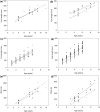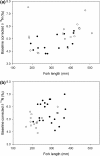Invasive crayfish impacts on native fish diet and growth vary with fish life stage
- PMID: 32269451
- PMCID: PMC7115035
- DOI: 10.1007/s00027-016-0483-2
Invasive crayfish impacts on native fish diet and growth vary with fish life stage
Abstract
Assessing the impacts of invasive organisms is a major challenge in ecology. Some widespread invasive species such as crayfish are potential competitors and reciprocal predators of ecologically and recreationally important native fish species. Here, we examine the effects of signal crayfish (Pacifastacus leniusculus) on the growth, diet, and trophic position of the chub (Squalius cephalus) in four rivers in Britain. Growth rates of 0+ chub were typically lower in sympatric populations with signal crayfish compared with allopatric populations, and this effect could be traced through to 2+ chub in one river. However, growth rates of older chub (5+ to 6+) were typically higher in the presence of crayfish. Sympatry with crayfish resulted in lower chub length-at-age and mass-at-age in half of the rivers sampled, with no change detected in the other rivers. Stable isotope analyses (δ13C and δ15N) revealed that both chub and crayfish were omnivorous, feeding at multiple trophic levels and occupying similar trophic positions. We found some evidence that chub trophic position was greater at invaded sites on one river, with no difference detected on a second river. Mixing models suggested crayfish were important food items for both small and large chub at invaded sites. This study provides evidence that invasive species can have both positive and negative effects on different life stages of a native species, with the net impact likely to depend on responses at the population level.
Keywords: Chub Squalius cephalus; Competition; Diet shift; Invasive species; Scalimetry; Signal crayfish Pacifastacus leniusculus; Stable isotopes.
© The Author(s) 2016.
Figures





References
-
- Allouche S, Gaudin P. Effects of avian predation threat, water flow and cover on growth and habitat use by chub, Leuciscus cephalus, in an experimental stream. Oikos. 2001;94:481–492. doi: 10.1034/j.1600-0706.2001.940310.x. - DOI
-
- Bašić T, Britton JR, Jackson MC, Reading P, Grey J. Angling baits and invasive crayfish as important trophic subsidies for a large cyprinid fish. Aquat Sci. 2015;77:153–160. doi: 10.1007/s00027-014-0370-7. - DOI
-
- Blake MA, Hart PJB. The vulnerability of juvenile signal crayfish to perch and eel predation. Freshw Biol. 1995;33:233–244. doi: 10.1111/j.1365-2427.1995.tb01164.x. - DOI
-
- Bolland J, Britton JR, Cowx IG. Lifetime consequences of variable 0 year group length in riverine populations of chub Leuciscus cephalus (L.) J Fish Biol. 2007;71:1810–1819. doi: 10.1111/j.1095-8649.2007.01650.x. - DOI
-
- Bondar CA, Bottriell K, Zeron K, Richardson JS. Does trophic position of the omnivorous signal crayfish (Pacifastacus leniusculus) in a stream food web vary with life history stage or density? Can J Fish Aquat Sci. 2005;62:2632–2639. doi: 10.1139/f05-167. - DOI
LinkOut - more resources
Full Text Sources
